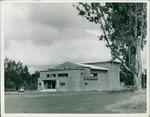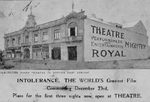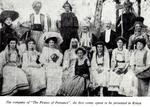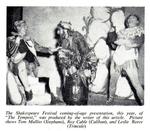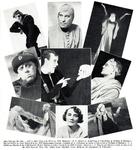THIS BRIEF HISTORY OF THE THEATRE IN Kenya
So, what happened in the early 1900’s for entertainment whilst a new town was to blossom in its inception to become what we now know it to be the capital city
Nairobi. People of different walks of life kept themselves engaged with ameliorating with their lives away from the disdain of that era and in search for happiness even if it meant for a short period
of time in keeping the amusement alive and having fun..
Here is a story about how people kept them entertained over that difficult era of time for whatever reason or in what life may have thrown at them and with it subconsciously strode to capture that
happiness and share with its audiences no matter what historical times or environment unfolded over time and actually reaching the heights of pinnacles in entertainment to the iconic Theatre Royal
and later resulting in Kenya getting the first real National Theatre in the British Empire …
THIS BRIEF HISTORY OF THE THEATRE IN Kenya can offer only an outline of the many achievements that have helped contribute to its successful development.
There has been intense activity in all branches of stagecraft throughout the fifty- four years since the first settlers and officials presented Nairobi’s
initial stage show, narrated by A. J.R Master dated 1954/55.
This was given in the old wood and iron building which still stands at the bottom, left hand side, of Whitehouse Road. The artists and audience were so eager
to launch their show that they presented it before the builders had fitted all the floor boards in the hall, and many people sat on the bare joists with their legs dangling
below.
The following year, 1901, the erection of the big Railway Institute (on the land now covered by the Military Records Office) provided a building more suited
to house entertainments. The designers, however, had failed to provide a stage. Local ingenuity quickly overcame this deficiency by constructing a temporary platform on weighted barrels. This
temporary stage was so well designed that the sturdy oak staves became the foundations on which the live theatre of Kenya grew and flourished until the old Railway Institute was
demolished.
Members of the Railway staff welcomed other organisations to their hall and this first-established centre of Kenya’s culture soon became known as “ The Theatre.”
References to Mr. W. D. Young appear more frequently than any other person in the earliest theatre records. Then comes the name of Mr. R. H. Theo Blunt, now
the doyen of the Kenya stage, who still delights listeners with his Scrooge broadcasts every Christmas.
Plays had been performed from the start in the Institute. Then, in 1907, Nairobi saw its first local pantomime with a “season” running into the New Year of
1908. The pantomime was a topical version of Bluebeard, with its scenes set in the Ngong Hills, written and devised by Nairobi’s first dramatist, playwright and rhymester in stage lyrics, Mr. W. J.
Monson.
An orchestra was made up of people whose names are still known in the Colony: Messrs. Hoey, Hawley, Grice, Miles and Isherwood. No pantomime would be complete
without dancers, and the honour of having been Kenya’s first ballerina is held by Miss Ethel Sandford, now Mrs. C. N. M. Harrison, mother of a charming and dainty actress, Barbara Larby. This first
pantomime also introduced a gifted comedian to the Kenya stage in Mr. (now Colonel) T. O. FitzGerald, whose performance was described, “excellent acting, foolery, yet, withal, always graceful and
easy characterisation . . . .”
From 1908 there are numerous records of theatre enter¬tainments with the names of Mr. R. H. Theo Blunt, Mr. T. O. FitzGerald, Miss Northey, Miss McDonnell,
Messrs, Trim, McClure, Bullows and Charles Udall, frequently appearing in the casts. The peak to all the activities seemed to have been reached in 1909 when Nairobi’s first comic opera was put into
rehearsal.
This was Gilbert and Sullivan’s The Pirates of Penzance, presented during the beginning of 1910. Among the cast are the names of Messrs. Balmer, Lewison, Charles Udall, Ted Trim, P. E. Wolffe, F. A.
Mageean, R. H. Theo Blunt, S. A. Hawkins, Mrs. T. A. Irwin, Mrs. R. C. Grant, Mrs. Elliott, Miss M. Mortimer, Miss Rehm, Mrs. (later Lady) Bowring and the Colony’s first prima donna Miss A. Mortimer
(now Lady Vincent), with Mr. T. A. Irwin as the musical director.
A new building was opened in Government Road during 1911 to house Garvie’s Tea Rooms and Entertainment Hall. Here Dr. Dan Wilson was the producer of stage
entertainments in which Mrs. E. K. Figgis and Mrs. Playfair appeared.
Then followed the building of the Assembly Rooms (subsequently known by several other names including those of Gaiety Theatre and New Theatre House) in Sixth
(now Delamere) Avenue.
The first big attraction prepared there was in 1912, when a production of Gilbert and Sullivan’s H.M.S. Pinafore was rehearsed.
The Theatre Royal building was completed by Mr. Samuel Medicks in 1913, to which the production of H.M.S. Pinafore was transferred for the opening performance. Then came Gilbert and Sullivan’s The Mikado, with R. H. Theo Blunt playing his favourite role of Koko. Among other names recorded in this production are those of P. Ernest Wolffe, Frank J. Bullows, A. Vincent, Charles Udall, Annie Morti- Theo Blunt in a favourite role, mer, Amy Irwin, Eleanor Koko, in "The Mikado" Watson, Mollie Mortimer,E. Ulyate, Annie Firth and Arthur Goodwin.
From then, onwards, the Theatre Royal became the centre of all stage activities and remained so, with short breaks, for forty years which finally closed after
five years of glory in the service of charity and war welfare.
The original building had ample dressing rooms, perfect acoustics, electric lighting for the stage and a comfortable auditorium seating about 500 people. The
Royal was acknowledged to be the finest theatre between Cairo and the Cape.
During the 1914-1918 war it was in continuous occupation, and from these activities developed a famous “ Follies ” troupe. The Kilalians (Kilale, in Swahili,
means noise!). The troupe remained active until 1922 and gave a further impetus to local stage efforts.
Among the brightest Kilalian stars were Mr. R. H. Theo Blunt, Mrs. Jack Irwin, Mrs. Arthur Doyle, Mr. E. K. Figgis (who was to do so much for the later development of music in the Colony), Arthur White (founder of the Kenya Musical Festivals), Mabel Blackwell (whose brilliance in comedy roles made her the darling of the Kenya stage) and Eric Schwartze (who later made an outstanding contribution to the improvement of local production standards).
Several former professionals and gifted artists came to live in Kenya and gave freely of their talent.
Music was also receiving serious attention. The K.A.R. band had been formed in 1907, under the direction of a Goan Bandmaster named Pinto. During 1915, Mr. C.
A. Harvey became the K.A.R. Bandmaster and achieved wonders with illiterate bandsmen recruits through his system of teaching them to recognise the value of music notes by making them count equivalent
numbers of the currency coins with which they were familiar.
After successfully developing the K.A.R music talent, Mr. Harvey turned his attention to a theatre orchestra with N. K. Kilminster, R. A. Hawkins and W. A. Nicholson. They started a movement that has been maintained with a continuous endeavour for high standards of performance among local instrumentalists, many of whom, to-day, are Asian and African.
It was during 1916 that the first professional theatre group came to tour the country, led by Leonard Rayne. One of the actresses, Miss Daphne Lange,
abandoned her stage career to become Mrs. Darling and settled on a farm with her husband at Thika.
Working among all the theatre groups, but finding most satisfaction in the lighter types of Follies and Revues, was a young man, Arthur George Higgins who,
years later, became one of Kenya’s leading Shakespearian actors.
During the 1920-30 period a new vaudeville troupe was formed at the Lyric Hall with Mrs. A. M. (“ Pat ”) Green, Miss Norman, Miss Lunn, Mr. and Mrs. Hawkins,
Mr. E. K. Figgis, Mr. J. B. Witherick, Mr. Carriline, Capt. A. H. Smith and Nellie Shaw of the sweet soprano voice. The principal instrumentalists were Irene Massiah, Colonel Ley and Mrs. Whitworth.
This company introduced a male quartet which enjoyed many years of popularity under the title of “ The Four W’s ”—J. B. Witherick, Leonard M. Wood, H. Wilkinson and J. A.
Whitworth.
Touring professional musicians were being attracted to the growing Colony. As a young girl, Marie Shorten visited Kenya in 1912; she returned in 1926 as a
famous singer, to give recitals at the Lyric Hall where she created what the local newspapers described as “a furore.” The Kenya Festivals of speech and music were established in 1927, organized by
Irene Massiah and A. B. Ginns under the direction of Arthur White. Irene Massiah also became musical director of George Higgins wrote his first Revue and Eric Schwartze made his bow as a director of
Gilbert and Sullivan productions.
These individual efforts for music and drama brought to the stage many gifted people.
Then came a production of Sally to set Harry F. Hawes in the front rank of local comedy actors, from which he went on to prove himself equally gifted in
pantomime (as a comedy dame), all types a newly-formed operatic company in 1927, the year Arthur of modern drama and, finally, as a Shakespearian actor of considerable
distinction.
The Festivals for speech and music continued, attracting other well-known visiting artistes as adjudicators. The 1928 festival had the world-famous viola
player.
William Primrose, and singer Percy Hemming on the panel. In the following year, Madame Santanera, the gifted instrumentalist, visited Kenya to give recitals
on her harp that enraptured Theatre Royal audiences. There were oratorios and cantatas, as well as operatic performances, with long lists of artists among whom frequently recur the names of A. B.
Ginns, Arthur White, W. Isherwood, Irene Massiah, J. Rawlins, Trevor Cole, Colet Birch, J. A. McCabe, Mrs Norbury, W. E. D. Knight, the McDonnell family, Alfred Vincent, the Wontner brothers, Mr. and
Mrs. Machin, Sydney Walter, Eileen Gillespie (now Mrs. Patley), Iris Durham, Kitty Flint, the Condon brothers and sisters, Grace Penny (now Mrs. FitzGerald) and W. F. Misquith.
Theatre companies journeyed from Mombasa, Nakuru, Thika, Molo and Kitale to present their productions in the capital. One of the most active and versatile
actresses of this time was Nellie Seymour James who was always ready to fill a gap in any programme with a solo number from an astonishingly extensive repertoire.
But gradually the leaders dispersed and the old Theatre Royal stage was deserted. Silent cinemato graph films were shown there, with the stage being used for
an occasional live production. The old Railway Institute, by this time known as the Railway Club, flashed back into the theatre story during 1929 with the establishment of the Railway Players. This
organisation set out to produce worthwhile plays, with a complete disregard of box office results. The first production upset this idealistic plan by proving a great box office attraction with “
house full ” notice boards out and many people turned away at each performance. The play was Sutton Vane’s Outward Bound.
Its unexpected financial success caused other interests to take notice. While a series of plays of outstanding quality was being presented, it became
necessary to discontinue performances at the club because it had not been constructed to requirements for public performances, which resulted in Kenya’s first “ Little Theatre ” having to close its
doors and transfer activities to the rented stages of town cinemas. This demanded a change in policy, resulting in the Railway Players having to consider that commercial evil, the box
office.
The Players undertook regular broadcast engagements, making a special feature of works by Shakespeare for the poet’s birthday. They launched the East African
Shakespeare Festivals in 1933, with Hamlet at the Theatre Royal.
These Shakespeare Festivals grew steadily in importance with broadcasts, lectures and the full stage productions of one Shakespeare play each year. The first year only two stage performances were given, but now the numbers range from eight to twelve shows of each play presented.
In the meantime the Empire Theatre was built, and Eric Schwartze presented Gilbert and Sullivan’s The Pirates of Penzance as the opening performance. The
auditorium of this new theatre could accommodate over eight hundred people. A professional touring company, known as “ The Globe Trotters” came to Kenya in 1930, and brought the versatile Eily
Gerald, one time Prima Ballerina for the Convent Garden Opera Company, who married and settled in the Colony and proved herself as accomplished an actress as she had been a
dancer.
Although the great depression of 1932 caused the Kenya Musical Festivals and several similar organisations to discontinue their activities, some made
determined efforts to maintain the cultural progress. Most of their endeavours were rewarded by generous public support. H. E. Schwartze remained active with productions of Gilbert and Sullivan
operas and popular straight plays with R. H. Theo Blunt his able lieutenant.
Mrs. Eileen Leslie Melville appeared in all types of entertainment to enliven them with her gay presence, ranging from Revue to Pantomime, until, eventually,
she, also, launched out as a producer.
The Pharazyns brought their companies from Kitale, and the McEntees came with the Swifts with excellently cast shows from Thika.
So much friendly rivalry helped inspire a high standard of production and performance while contributing the much- needed mental uplift to counteract the
effects of a worldwide depression.
The Playhouse Theatre was built as a cinema with a small stage equipped for live shows. An ardent supporter of the local theatre, Wilfred Harris, joined with
Messrs. Vasey and Weatherall to present a series of stage plays there, but these lad to give place eventually to a monopoly by films. Most people who lived in Nairobi at that time seem to have acted
in some local stage production or pageant, and these made up most discerning audiences for every stage show presented.
Ronald Frankau brought a London Company on a tour of East Africa in 1932, and in the Company, as pianist and comedienne, was Miss Gwen Alban, who married Mr.
Edward Barrett and settled in Kenya to become the First Lady of the Lenya Stage.
Nairobi Musical Society had been formed by people who had played for the big musical shows from 1936. Their leaders were Sydney Walter and Ethel McHugh, and
the society roved fortunate in having a succession of energetic secretaries i Mimi Walter, Ruth Johnson (now Mrs. H. Markus), Mrs. J. C. Mundy, Mrs. Modera, Mrs. George (Eva) Kenworthy and Miss
Audrey Wheelock. To-day it has something approaching 500 members.
When the 1939-1945 war was declared, the Governor’s wife, Lady Brooke-Popham, promptly formed an entertainment unit for the troops camped throughout
Kenya.
First efforts were concentrated on touring concert parties, but at the end of 1939 a more ambitious plan was afoot for Troops’ Entertainment Panto-Rag of
Cinderella. Organized a credit, with no funds and no hope of a proper stage for its performance, the script was written mainly by Billie and Renee (now Mrs. Roger Wilkinson) Bradbury. The Royal Air
Force Camp Commandant had a dormitory converted Nairobi West for a theatre, and transport was arranged to bring men in from different camps each
night.
The company insisted of Norah Soulsby, G. N. Poynton, Dorothy Bishop, . Barker, J. B. Witherick, Susan Bartlett, Billy Norbury, Donough Coffey, Diana Brown, Peggie Douglas, Sheilah Douglas, Douglas
R. Douglas, Valerie Skelton, Ada Atwill, Suzanne Allen, Pat Bate, Joan Rogers, Juju Muter, Helen Bell, Iris Durham, Jimmy Firth, Harry F. Hawes, F. C.Chiristie, Billie Bradbury, Renee Bradbury, Susan
Kaplan, A. G. Bishop, and a small orchestra under the direction of Mrs. Railton Tarr.
Many worthy townsfolk of Nairobi declared they would gate crash the dormitory-theatre if a public showing could not be arranged. This led to the pocket-sized
Panto-Rag being transferred to the Empire Theatre in January, 1940, where it earned sufficient money to finance a tour and en¬couraged the organising committee to face five years of costly
entertainments given free to the Forces.
The musical festivals were discontinued. The Railway Players united with the troop and charity entertainment organizations to help the war effort. Then Mr.
Samuel Medicks offered the disused Theatre Royal, rent free, for war charities and troop entertainments. After a few months of teething troubles the old Theatre Royal became the centre of ceaseless
stage activity until the war ended. War charities benefited by large sums earned from performances to the public while members of the Forces were given free shows of all productions presented in the
theatre.
Mr. Samuel Medicks died at the end of the war, which terminated his generous gift of the rent free occupation of the Theatre Royal and once again its doors
were closed to reopen some months later for cinema shows.
A few enthusiasts came forward with determination to get a permanent home for the theatre arts. Their intention— building a National Theatre—seemed over-ambitious, but Mrs. Hughes designed a theatre and the Government allocated a free plot of land opposite the Norfolk Hotel.
The scheme was launched with resounding cheers at a huge Theatrical Garden Party Fete and a large-scale “ Pageant of the British Theatre ” on the old Race
Course. An impressive model of the proposed theatre attracted much attention, and all seemed set for success when it was learned that another committee had been formed to explore the possibilities of
establishing a Cultural Centre which would also include a theatre on a Government plot of land near the Norfolk Hotel.
This led the National Theatre trustees to pool their funds with the greater scheme, resulting in Kenya getting the first real National Theatre in the British
Empire. Opened with pomp and ceremony in November, 1952, it is for the benefit of all races in the Colony. Every type of stage activity is encouraged, as well as lectures, film shows and all kinds of
charitable, scientific and cultural meetings.
The auditorium holds 400 people and the design is as an all-purposes theatre and lecture hall with generous stage working areas. Attached to the theatre is a fine collection of stage books and
photographs, originally collected by the late A. E. Hanford and presented by his daughter, Mrs. Derek Haggie of Turbo.
A Shakespeare Corner has been established in the foyer and items of general theatre interest are being collected to make a real Centre of the Arts. There are
thirty constituent member organizations interested in the development of this Centre, of which the Theatre is merely the first section to be completed.
During the time the National Theatre was being planned there arrived in Nairobi two theatre enthusiasts, Mr. and Mrs. Donovan Maule, who set about
establishing their own Studio Theatre in a cleverly adapted former dance studio situated in the lower part of the Government Road business area.
This successful little Theatre is run on the membership system, offering a different production each month. A recent extension of the Studio is a service for
theatre lighting, make-up, sound effects, properties and costumes.
The festivals of music and speech were revived in 1950, under the auspices of the Nairobi Musical Society, with visiting adjudicators for music and a panel of
local people for the speech contests. Having the National Theatre to house these festivals has enabled the organizers to run for a week. This year the competitions were extended to dancing which adds
even greater importance to the event.
The first Kenya Drama Festival was held in the National Theatre during 1953, when, in face of the emergency difficulties, six teams competed with the Nakuru
entry gaining first place. They have now become an annual event.
The next step will be the formation of a Theatre Guild, with the National Theatre as the centre of Colony-wide activities.
This year the Railway Players celebrated their quarter- of-a-century and the coming-of-age of the East African Shakespeare Festivals with a production of The Tempest. The production was dressed by costumes from the Stratford- on-Avon Shakespeare Memorial Theatre wardrobe.
The work of fifty-four years has been a period of continual progress of which the early settlers are justly proud.
We move forward in harmony for the development of the arts among all races who live in this beautiful land which straddles the equator.
Acknowledgment : The majority of photographs illustrating this article are from the collection of Mr. & Mrs. H. K. Binks, Nairobi.
Erratum : The photograph is of the first pantomime in Nairobi, in 1907-8, not of the “Pirates of Penzance".



